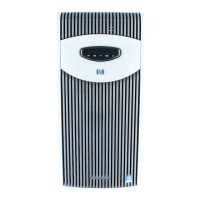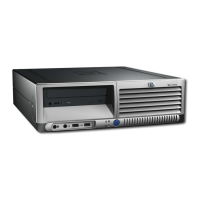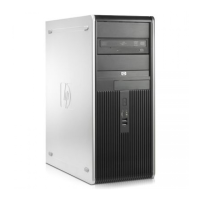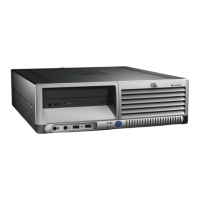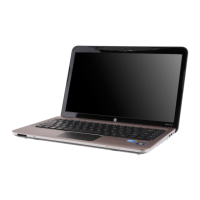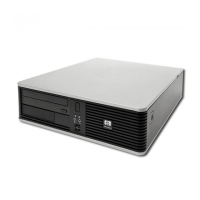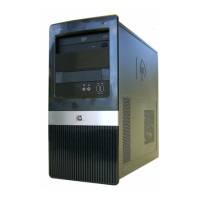Do you have a question about the HP DL580 - ProLiant - G4 and is the answer not in the manual?
Identifies and lists mechanical components within the server. Includes part numbers.
Lists and identifies system-level components and boards of the server.
Covers required tools, safety considerations including ESD, and server warnings.
Procedure for extending the server from its rack for access to internal components.
Steps to safely shut down the server and disconnect power before servicing.
Instructions for safely removing the server unit from a rack cabinet.
Procedure for removing the server's main access panel to reach internal components.
Detailed steps for removing the server's front bezel assembly.
Procedure for removing the internal system cage to access specific components.
Instructions for removing optical drives or blank media bay fillers.
Steps to safely remove the entire processor module assembly from the server.
Procedure for replacing individual processors or processor blank modules.
Details on removing and installing a Processor Power Module (PPM).
Procedure for removing the retention latch for PCI expansion slots.
Steps to remove the retaining clip securing PCI expansion boards.
Procedure for removing the cover plates for unused expansion slots.
Instructions for removing standard expansion boards from PCI slots.
Procedure for removing the hot-plug basket for PCI-X expansion cards.
Steps to remove hot-plug PCI-X expansion boards from the server.
Procedure for removing the PCI-X Hot Plug mezzanine board.
Procedure for removing the PCI Express mezzanine board.
Steps to recover data temporarily stored in the Battery-Backed Write Cache.
Procedure for safely removing the BBWC battery pack.
Steps for removing the BBWC cache module from the controller.
Detailed procedure for removing and replacing the server's main system board.
Procedure to re-enter server identification details after system board replacement.
Guide for replacing the server's real-time clock battery.
Procedure for removing the server's media board.
Steps to remove the media pass-through board.
Procedure for removing the SAS backplane from the hard drive cage.
Instructions for removing the server's power backplane.
Procedure for removing the memory backplane from the server.
Procedure for removing or replacing a hard drive bay blank.
Detailed steps for replacing hot-plug SAS hard drives.
Procedure for removing or replacing a power supply bay blank.
Instructions for replacing a hot-plug power supply unit.
Procedure for replacing hot-plug fans to maintain server cooling.
Details on server memory capacity, type, and supported Advanced Memory Protection (AMP) options.
Guidelines for populating DIMMs and memory boards for optimal server performance.
Explanation of single- and dual-rank DIMMs and their configuration impact.
Details on the default memory protection mode and its error correction capabilities.
Information on configuring online spare memory for enhanced availability.
Details on mirrored memory for data protection and hot-replace capabilities.
Information on RAID memory for protection against uncorrectable errors.
Steps for configuring memory hardware and software for desired AMP modes.
Procedure for running the Power-On Self Test memory diagnostic.
Instructions for using ROM-based diagnostics for system testing.
Guide to selecting Advanced Memory Protection modes using RBSU.
Procedure for removing or replacing a memory board blank.
Instructions for removing non-hot-plug memory boards.
General procedures for removing and replacing memory boards.
Detailed steps for removing and replacing individual DIMMs on a memory board.
Description of SmartStart software for server setup and configuration.
Tool for automating server configuration and deployment for high volumes.
Proactive remote monitoring and diagnostic tool for managing systems and devices.
Utility for creating logical drives, assigning RAID levels, and configuring storage.
Embedded utility for configuring server hardware, system features, and options.
Utility for upgrading system firmware (BIOS) or Lights-Out firmware.
Tool for efficiently upgrading system or controller ROM images across servers.
Records and stores system events with timestamps for easy viewing and analysis.
Provides server health and remote manageability independently of the host OS.
Feature that automatically restarts the system after catastrophic OS errors.
Web-based application for managing systems and consolidating device data.
Proactive tool for server diagnostics, troubleshooting, and repair validation.
Details on standard and legacy USB support provided by the server.
Guide to interpreting port 85 error codes for system diagnostics.
Specific troubleshooting steps for port 85 codes indicating processor errors.
Troubleshooting steps for port 85 codes related to memory errors.
Troubleshooting steps for port 85 codes indicating expansion board issues.
Troubleshooting steps for port 85 codes covering various other system areas.
Identifies and labels components located on the server's front panel.
Explains the status indicators and controls on the server's front panel.
Details on memory board parts and the meaning of their status LEDs.
Explains the status indicators for processor modules and PPMs.
Identifies and labels all connectors and ports on the server's rear panel.
Explains the status indicators and controls on the server's rear panel.
Interprets the status indicators for the server's power supply units.
Diagram and labels for key components found on the server's system board.
Configuration options for the eight-position system maintenance switch.
Determines the device access order for multibay drives during boot.
Procedure to configure the Systems Insight Display to show port 85 codes.
Location and function of the Systems Insight Display LEDs on the media board.
Diagram showing DIMM slot numbering and bank assignments on the memory board.
Information on how SAS and SATA drives are numbered in the server.
General guidelines for installing SAS and SATA hot-plug hard drives.
Explanation of the LED indicators for SATA and SAS hard drives.
Interpretations of combined LED states for SAS and SATA hard drives.
Identifies the locations of the six system fans and their zones.
Explains the status indicators for hot-plug system fans.
Guidelines for connecting storage devices to the server.
Procedure for connecting the PCI-X Hot Plug mezzanine board.
Cabling instructions for the Battery-Backed Write Cache module.
Instructions for connecting hot-plug SAS and SATA hard drives.
Procedure for connecting the front panel USB connector to the media backplane.
Instructions for connecting the server's power switch cable.
Procedure for connecting the front panel video connector cable.
Details on operating and shipping temperature and humidity ranges.
Includes dimensions, weight, input requirements, and power output.
Guidance on calculating electrical and heat loading for hot-plug power supplies.
List of essential information to have ready when contacting HP support.
Contact details for HP authorized resellers and technical support.
Identifies and lists mechanical components within the server. Includes part numbers.
Lists and identifies system-level components and boards of the server.
Covers required tools, safety considerations including ESD, and server warnings.
Procedure for extending the server from its rack for access to internal components.
Steps to safely shut down the server and disconnect power before servicing.
Instructions for safely removing the server unit from a rack cabinet.
Procedure for removing the server's main access panel to reach internal components.
Detailed steps for removing the server's front bezel assembly.
Procedure for removing the internal system cage to access specific components.
Instructions for removing optical drives or blank media bay fillers.
Steps to safely remove the entire processor module assembly from the server.
Procedure for replacing individual processors or processor blank modules.
Details on removing and installing a Processor Power Module (PPM).
Procedure for removing the retention latch for PCI expansion slots.
Steps to remove the retaining clip securing PCI expansion boards.
Procedure for removing the cover plates for unused expansion slots.
Instructions for removing standard expansion boards from PCI slots.
Procedure for removing the hot-plug basket for PCI-X expansion cards.
Steps to remove hot-plug PCI-X expansion boards from the server.
Procedure for removing the PCI-X Hot Plug mezzanine board.
Procedure for removing the PCI Express mezzanine board.
Steps to recover data temporarily stored in the Battery-Backed Write Cache.
Procedure for safely removing the BBWC battery pack.
Steps for removing the BBWC cache module from the controller.
Detailed procedure for removing and replacing the server's main system board.
Procedure to re-enter server identification details after system board replacement.
Guide for replacing the server's real-time clock battery.
Procedure for removing the server's media board.
Steps to remove the media pass-through board.
Procedure for removing the SAS backplane from the hard drive cage.
Instructions for removing the server's power backplane.
Procedure for removing the memory backplane from the server.
Procedure for removing or replacing a hard drive bay blank.
Detailed steps for replacing hot-plug SAS hard drives.
Procedure for removing or replacing a power supply bay blank.
Instructions for replacing a hot-plug power supply unit.
Procedure for replacing hot-plug fans to maintain server cooling.
Details on server memory capacity, type, and supported Advanced Memory Protection (AMP) options.
Guidelines for populating DIMMs and memory boards for optimal server performance.
Explanation of single- and dual-rank DIMMs and their configuration impact.
Details on the default memory protection mode and its error correction capabilities.
Information on configuring online spare memory for enhanced availability.
Details on mirrored memory for data protection and hot-replace capabilities.
Information on RAID memory for protection against uncorrectable errors.
Steps for configuring memory hardware and software for desired AMP modes.
Procedure for running the Power-On Self Test memory diagnostic.
Instructions for using ROM-based diagnostics for system testing.
Guide to selecting Advanced Memory Protection modes using RBSU.
Procedure for removing or replacing a memory board blank.
Instructions for removing non-hot-plug memory boards.
General procedures for removing and replacing memory boards.
Detailed steps for removing and replacing individual DIMMs on a memory board.
Description of SmartStart software for server setup and configuration.
Tool for automating server configuration and deployment for high volumes.
Proactive remote monitoring and diagnostic tool for managing systems and devices.
Utility for creating logical drives, assigning RAID levels, and configuring storage.
Embedded utility for configuring server hardware, system features, and options.
Utility for upgrading system firmware (BIOS) or Lights-Out firmware.
Tool for efficiently upgrading system or controller ROM images across servers.
Records and stores system events with timestamps for easy viewing and analysis.
Provides server health and remote manageability independently of the host OS.
Feature that automatically restarts the system after catastrophic OS errors.
Web-based application for managing systems and consolidating device data.
Proactive tool for server diagnostics, troubleshooting, and repair validation.
Details on standard and legacy USB support provided by the server.
Guide to interpreting port 85 error codes for system diagnostics.
Specific troubleshooting steps for port 85 codes indicating processor errors.
Troubleshooting steps for port 85 codes related to memory errors.
Troubleshooting steps for port 85 codes indicating expansion board issues.
Troubleshooting steps for port 85 codes covering various other system areas.
Identifies and labels components located on the server's front panel.
Explains the status indicators and controls on the server's front panel.
Details on memory board parts and the meaning of their status LEDs.
Explains the status indicators for processor modules and PPMs.
Identifies and labels all connectors and ports on the server's rear panel.
Explains the status indicators and controls on the server's rear panel.
Interprets the status indicators for the server's power supply units.
Diagram and labels for key components found on the server's system board.
Configuration options for the eight-position system maintenance switch.
Determines the device access order for multibay drives during boot.
Procedure to configure the Systems Insight Display to show port 85 codes.
Location and function of the Systems Insight Display LEDs on the media board.
Diagram showing DIMM slot numbering and bank assignments on the memory board.
Information on how SAS and SATA drives are numbered in the server.
General guidelines for installing SAS and SATA hot-plug hard drives.
Explanation of the LED indicators for SATA and SAS hard drives.
Interpretations of combined LED states for SAS and SATA hard drives.
Identifies the locations of the six system fans and their zones.
Explains the status indicators for hot-plug system fans.
Guidelines for connecting storage devices to the server.
Procedure for connecting the PCI-X Hot Plug mezzanine board.
Cabling instructions for the Battery-Backed Write Cache module.
Instructions for connecting hot-plug SAS and SATA hard drives.
Procedure for connecting the front panel USB connector to the media backplane.
Instructions for connecting the server's power switch cable.
Procedure for connecting the front panel video connector cable.
Details on operating and shipping temperature and humidity ranges.
Includes dimensions, weight, input requirements, and power output.
Guidance on calculating electrical and heat loading for hot-plug power supplies.
List of essential information to have ready when contacting HP support.
Contact details for HP authorized resellers and technical support.
| Product Type | Server |
|---|---|
| Memory | Up to 64 GB DDR2 |
| Product Name | HP ProLiant DL580 G4 |
| Form Factor | Rack-mountable |
| Processor | Intel Xeon |
| Power Supply | Redundant power supplies |
| Network Controller | Embedded Gigabit Ethernet |
| Expansion Slots | PCI-X slots |
| Operating System Support | Windows Server, Linux |
| RAID Controller | HP Smart Array P400i or P400 |





